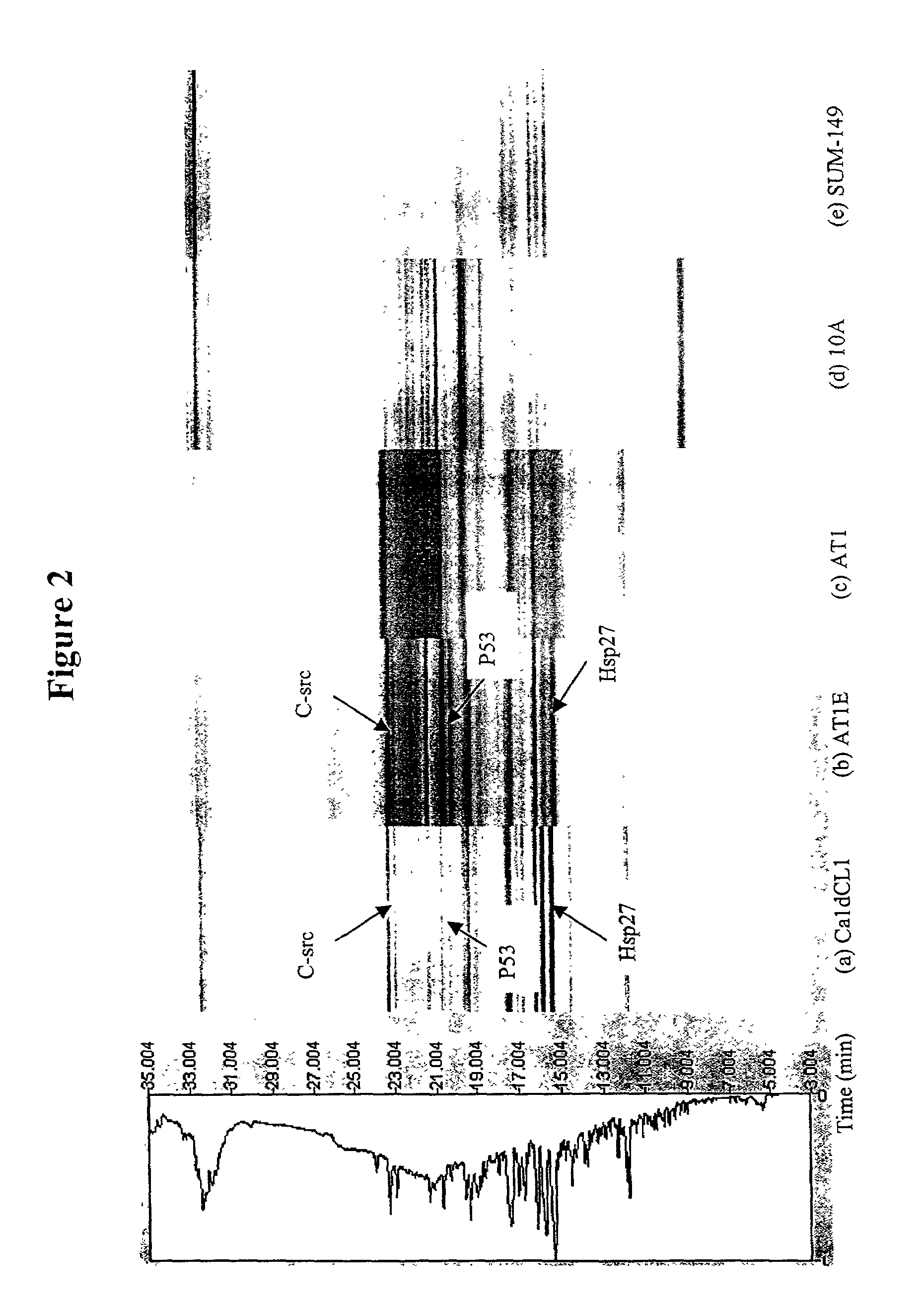Mapping of differential display of proteins
a technology of differential display and protein, applied in the field of protein separation systems and methods, can solve the problems of difficult reproduction, difficult differential expression confirmation, and inability to explain the expression patterns of proteins produced from these genes
- Summary
- Abstract
- Description
- Claims
- Application Information
AI Technical Summary
Benefits of technology
Problems solved by technology
Method used
Image
Examples
example 1
MCF10 Cell Line
[0097]This example describes the properties, growth procedures, and lysis procedures of cell lines used in the following experiments. The MCF10 cell lines that were used in these experiments were obtained from spontaneously immortalized breast epithelial cells from a patient with fibrocystic disease (Soule et al., Cancer Research 50:6075 [1990]). The MCF10AT1 cell line produces xenograft lesions in immune deficient mice that resemble high risk proliferative breast disease in women. These lesions spontaneously progress to invasive carcinoma at about 25% incidence during the life of the host mouse (Miller et al., J. NatL Cancer Inst., 85:1725 [1993]; Dawson et al, Am. Journal of Pathology 1996, 148, 313–319.). Progression of the MCF10AT1 lesions in mice is accelerated by estradiol (Shekhar et al., Int. J Oncology 13:907 [1998]). Because exposure to estrogen is a generally accepted risk factor for breast cancer development, MCF10AT1 serves as an important model to test t...
example 2
Methods
[0103]This example illustrates some of the experimental methods utilized in the development of certain embodiments of the present invention.
[0104]A. Chemicals
[0105]The chemicals used in the following examples were used without prior purification. Acetone (HPLC grade) was obtained from Fisher (Fair Lawn, N.J.). Acetonitrile, guanidine hydrochloride (gu-HCl), α-cyano-4hydroxycinnamic acid (α-CHCA) trifluoroacetic acid (TFA), formic acid (FA), and octyl glucopyranoside (OCG) were from Aldrich (Milwaukee, Wis.). Trypsin was acquired from Promega (Madison, Wis.). Distilled and deionized water was obtained from Milli-Q reagent grade purification system from Millipore (Bedford, Mass.). The nitrocellulose (NC) used, Immobilin-NC pure was from Millipore.
[0106]B. HPLC
[0107]A Beckman (Fullerton, Calif.) System Gold HPLC was utilized. The pump (model 128) has a gradient solvent delivery module with built-in system controller. The detector was a programmable detector module (Model 166) wi...
example 3
Mass Mapping of Proteins from Premalignant and Malignant Cell Lines
[0118]This Example describes multidimensional NP-RP-HPLC-MS analysis of human breast cell lines representing different stages of neoplastic progression. An overview of the methodology is shown in FIG. 1. The cell lines utilized included MCF10A, which is a “normal,” but immortalized, cell line where the cell line keeps dividing but the phenotype is non-tumorigenic. The AT1 sample is considered a “premalignant” stage in progression. The AT1E lysate is the AT1 cell line that has been exposed to estradiol. The CaldCL1 is a highly malignant, tumorigenic cell line. These four cell lines have developed from a common precursor with essentially the same genetic background. The SUM-149 sample is a highly malignant cell line that has been developed from breast cancer tissue from a different patient and is included for comparison.
[0119]A. NP-HPLC and ESI-oa-TOF MS Analysis
[0120]An ODS2 nonporous column was used to separate the p...
PUM
| Property | Measurement | Unit |
|---|---|---|
| mass resolution | aaaaa | aaaaa |
| mass resolution | aaaaa | aaaaa |
| mass resolution | aaaaa | aaaaa |
Abstract
Description
Claims
Application Information
 Login to View More
Login to View More - R&D
- Intellectual Property
- Life Sciences
- Materials
- Tech Scout
- Unparalleled Data Quality
- Higher Quality Content
- 60% Fewer Hallucinations
Browse by: Latest US Patents, China's latest patents, Technical Efficacy Thesaurus, Application Domain, Technology Topic, Popular Technical Reports.
© 2025 PatSnap. All rights reserved.Legal|Privacy policy|Modern Slavery Act Transparency Statement|Sitemap|About US| Contact US: help@patsnap.com



